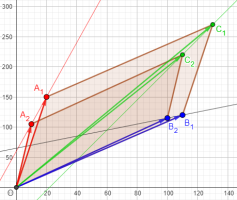Zombie1982
New member
- Joined
- Jan 3, 2024
- Messages
- 2
So my first post here and I think this is a pretty dumb problem and there's something very obvious I'm missing. However, after scratching my head for more than a day, I decide to seek community help solving this.
I am comparing two datasets- Acreage and Yield such that Acreage * Yield = Production. Consider the following table:
So Production for each state is calculated as Acreage * Yield; and for the "Total" (last row), the Average Yield is calculated as Production/Acreage. Now if Yield for 2023 is lower than that of 2022 for every single state, you would expect the Total Yield for 2023 to be lower than that of 2022. Somehow, that's not the case and I'm unable to wrap my head around this.
Any clues about how this is mathematically possible or what am I doing wrong?
Thanks in advance!
I am comparing two datasets- Acreage and Yield such that Acreage * Yield = Production. Consider the following table:
| S.no | State | Acerage 2022 (Ha) | Acerage 2023 (Ha) | % Change Acerage | Yield 2022 (MT/Ha) | Yield 2023 (Mt/Ha) | % Change Yield | Production 2022 (MT) | Production 2023 (MT) | % Change in Production |
| 1 | State 1 | 45,172 | 38930 | -14% | 3.2704 | 2.950 | -10% | 147,732 | 114,856 | -22% |
| 2 | State 2 | 168,891 | 57987 | -66% | 1.5128 | 1.356 | -10% | 255,502 | 78,613 | -69% |
| 3 | State 3 | 188,911 | 69091 | -63% | 1.2567 | 1.084 | -14% | 237,396 | 74,885 | -68% |
| 4 | State 4 | 33,462 | 29032 | -13% | 2.9235 | 2.827 | -3% | 97,826 | 82,060 | -16% |
| 5 | State 5 | 41,011 | 32873 | -20% | 1.6880 | 1.580 | -6% | 69,225 | 51,946 | -25% |
| 6 | State 6 | 21,219 | 11192 | -47% | 1.3407 | 0.900 | -33% | 28,448 | 10,073 | -65% |
| Total | 498,666 | 239,105 | -52% | 1.677 | 1.725 | 3% | 836,129 | 412,433 | -51% |
So Production for each state is calculated as Acreage * Yield; and for the "Total" (last row), the Average Yield is calculated as Production/Acreage. Now if Yield for 2023 is lower than that of 2022 for every single state, you would expect the Total Yield for 2023 to be lower than that of 2022. Somehow, that's not the case and I'm unable to wrap my head around this.
Any clues about how this is mathematically possible or what am I doing wrong?
Thanks in advance!

